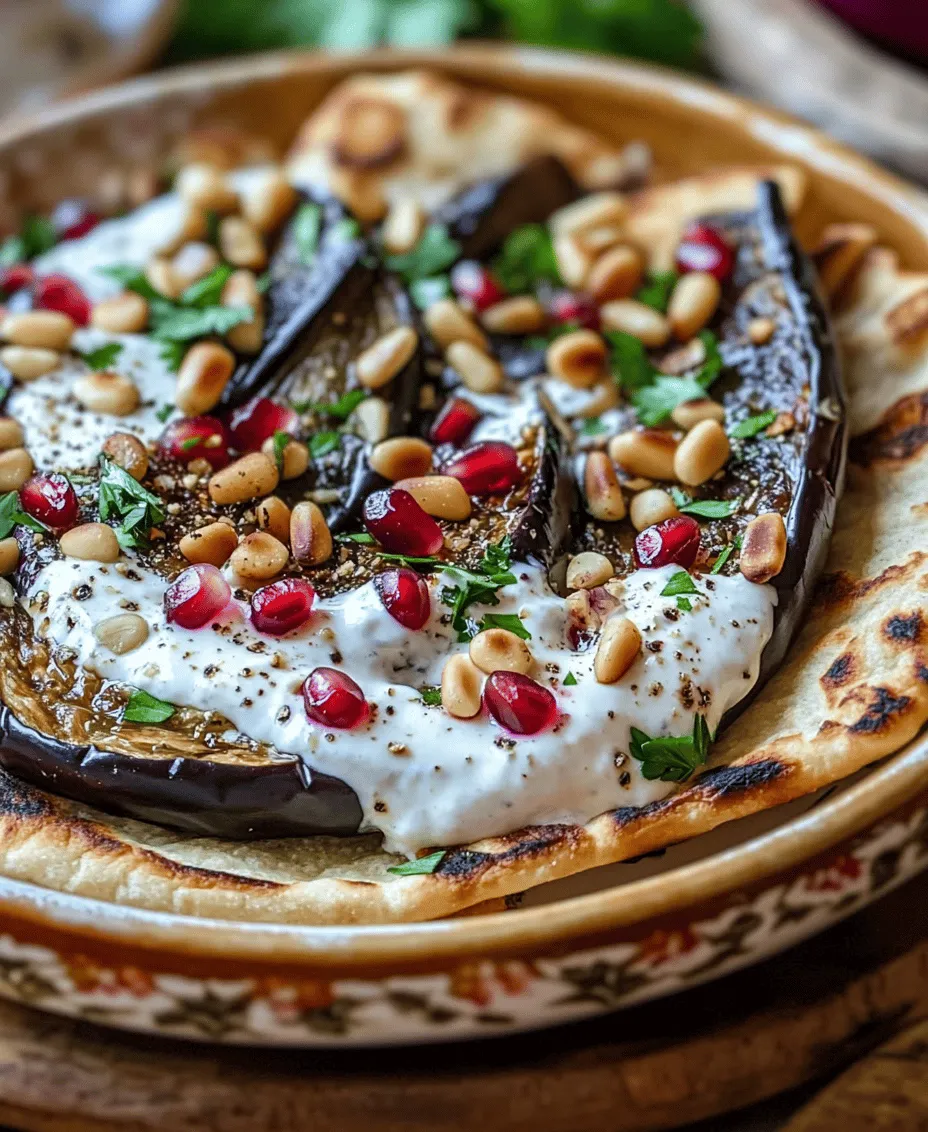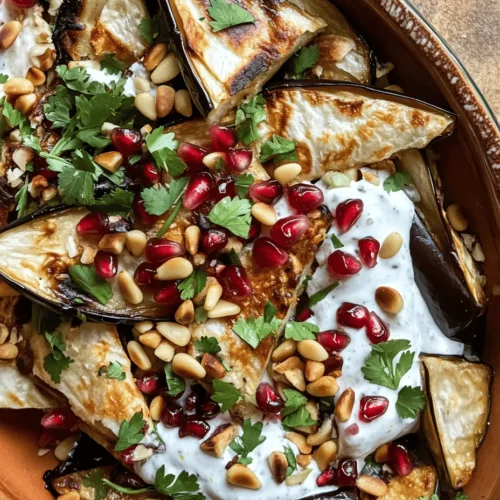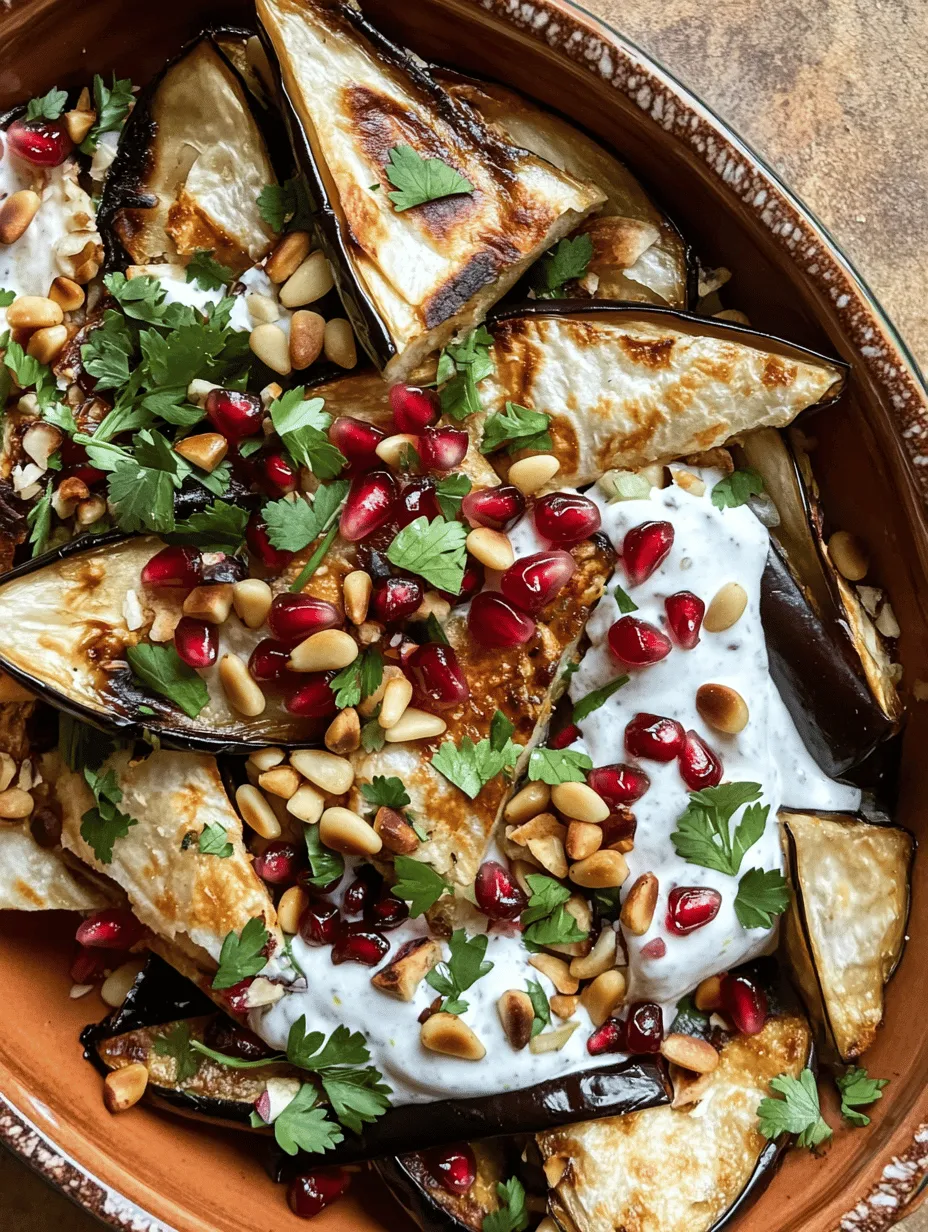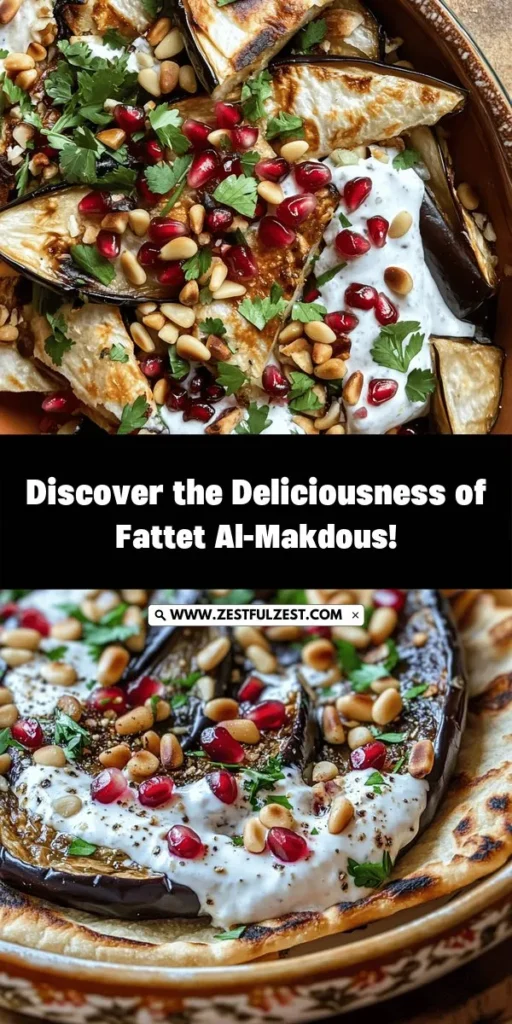Introduction
Fattet Al-Makdous is a beloved dish hailing from the rich culinary landscape of Syria, showcasing the vibrant flavors and textures that define Middle Eastern cuisine. This traditional recipe combines roasted eggplants with a creamy garlic yogurt sauce, toasted pita bread, and a medley of spices and fresh ingredients. Each bite of Fattet Al-Makdous offers a delightful experience, where the smoky undertones of eggplant meet the tangy richness of yogurt and the crunch of crispy bread, making it a favorite for both everyday meals and special occasions.
The appeal of Fattet Al-Makdous extends beyond its unique flavor profile; it also holds cultural significance in Syrian households, often served during gatherings and celebrations. It reflects the warmth and hospitality of Syrian culture, inviting friends and family to come together over a hearty meal. As a home cook, preparing this dish not only allows you to explore the depth of Syrian flavors but also enables you to share a piece of this culinary tradition with your loved ones.
In this article, we will delve into the key ingredients that bring Fattet Al-Makdous to life, explore their nutritional benefits, and provide you with step-by-step instructions for creating this delectable dish.
Understanding the Ingredients
Eggplants
At the heart of Fattet Al-Makdous are eggplants, which serve as the main ingredient and lend the dish its distinctive character. Eggplants are not only versatile but also packed with nutritional benefits. They are low in calories and high in fiber, making them an excellent choice for those looking to maintain a healthy diet. Rich in antioxidants, particularly nasunin, eggplants help combat free radicals in the body, promoting overall health.
When prepared properly, eggplants develop a rich, smoky flavor that enhances the dish’s overall taste. For Fattet Al-Makdous, it is essential to choose the right type of eggplant. Look for glossy, firm eggplants with no blemishes or soft spots. Smaller varieties, such as Japanese or baby eggplants, are often preferred for their tender texture and slightly sweeter flavor.
Yogurt
Yogurt is a staple in Middle Eastern cuisine and plays a crucial role in Fattet Al-Makdous. It adds a creamy texture and a tangy flavor that balances the richness of the roasted eggplants. Beyond its culinary significance, yogurt is also revered for its health benefits, being a great source of calcium, probiotics, and protein. These properties not only support digestive health but also contribute to a stronger immune system.
In this recipe, the yogurt is transformed into a garlic sauce that enhances the flavors of the dish. The combination of yogurt and garlic creates a robust, savory element that elevates Fattet Al-Makdous to new heights. While traditional yogurt is often used, you may also experiment with Greek yogurt for a thicker consistency and even more creaminess.
Tahini
Tahini is another essential component of Fattet Al-Makdous, contributing its rich, nutty flavor to the dish. Made from ground sesame seeds, tahini is a common ingredient in many Middle Eastern recipes, including hummus and baba ghanoush. It not only adds depth to the garlic yogurt sauce but also provides a creamy texture that ties the dish together.
In addition to its delightful flavor, tahini is packed with nutrients. It is a good source of healthy fats, vitamins, and minerals, making it a nutritious addition to your meals. The inclusion of tahini in Fattet Al-Makdous complements the eggplants and yogurt, creating a harmonious blend of flavors that captivates the palate.
Spices
Spices are the soul of Middle Eastern cuisine, and Fattet Al-Makdous is no exception. The dish typically features a blend of spices, including cumin, salt, and pepper, which enhance its overall flavor profile. Cumin, in particular, is celebrated for its warm, earthy aroma and is often used in savory dishes across various cultures. It not only adds depth to the taste but also has numerous health benefits, including aiding digestion and providing anti-inflammatory properties.
Salt and pepper are essential for seasoning, allowing the natural flavors of the ingredients to shine. When used judiciously, these spices elevate the dish without overpowering it, ensuring a well-balanced meal that’s both satisfying and delicious.
Fresh Ingredients
To finish off Fattet Al-Makdous, fresh ingredients such as lemon juice, parsley, and pomegranate are incorporated, bringing brightness and vibrancy to the dish. Lemon juice adds a refreshing zing that cuts through the richness of the yogurt and eggplants, while parsley provides a burst of color and a subtle herbal note.
Pomegranate seeds, often referred to as the jewels of the kitchen, not only enhance the visual appeal of the dish but also add a sweet-tart flavor that beautifully complements the other ingredients. Their juicy crunch creates a delightful contrast in texture, making every bite of Fattet Al-Makdous a flavorful experience.
Preparation Steps for Fattet Al-Makdous
Preparing the Eggplants
The first step in creating Fattet Al-Makdous is preparing the eggplants. This process involves roasting the eggplants to achieve that signature smoky flavor and tender texture.
1. Selecting the Eggplants: Start by choosing firm, medium-sized eggplants, as mentioned earlier. Look for those with smooth, shiny skin and avoid any that show signs of wrinkles or soft spots.
2. Trimming and Slicing: Wash the eggplants thoroughly and trim off the stems. Slice them in half lengthwise to expose the flesh. You can also choose to slice them into rounds if you prefer smaller pieces.
3. Salting the Eggplants: To draw out excess moisture and bitterness, sprinkle a generous amount of salt on the cut surfaces of the eggplants. Allow them to sit for about 30 minutes. You will notice beads of moisture forming on the surface. After this time, rinse the eggplants under cold water to remove the salt and pat them dry with paper towels. This step is crucial for achieving the perfect texture when roasting.
4. Roasting: Preheat your oven to 400°F (200°C). Place the salted and dried eggplants cut-side down on a baking sheet lined with parchment paper. Drizzle with olive oil, ensuring the eggplants are well coated. Roast in the preheated oven for about 30-40 minutes or until the eggplants are tender and golden brown. You can turn them halfway through the cooking time for even roasting.
Making the Garlic Yogurt Sauce
While the eggplants are roasting, you can prepare the garlic yogurt sauce, which is a key element of Fattet Al-Makdous.
1. Gathering Ingredients: For the sauce, you will need plain yogurt (or Greek yogurt), garlic cloves, tahini, lemon juice, salt, and a little water for consistency.
2. Mashing the Garlic: Start by peeling and crushing the garlic cloves. You can use a mortar and pestle for this, or simply mince them finely with a knife. The goal is to release the natural oils and flavors of the garlic.
3. Mixing the Sauce: In a mixing bowl, combine the crushed garlic with the yogurt and tahini. Add lemon juice and a pinch of salt. Mix well until the ingredients are fully integrated. If the sauce is too thick, add a little water, one tablespoon at a time, until you achieve a smooth, creamy consistency.
4. Taste and Adjust: Give the sauce a taste and adjust the seasoning as needed. You may want to add more lemon juice for tanginess or more garlic for a stronger flavor.
Toasting the Pita Bread
The final preparation step involves toasting the pita bread, which adds a delightful crunch to the dish.
1. Preparing the Pita: Take a few pieces of pita bread and cut them into triangles or strips, depending on your preference.
2. Toasting Method: You can toast the pita in several ways:
– Oven: Preheat your oven to 375°F (190°C). Arrange the pita pieces in a single layer on a baking sheet and brush them lightly with olive oil. Bake for about 10-15 minutes or until they are golden brown and crispy.
– Stovetop: Heat a skillet over medium heat. Place the pita pieces in the dry skillet and toast them for a few minutes on each side until they are crispy and slightly browned.
– Fryer: For a quicker option, you can deep fry the pita pieces in hot oil until golden and crispy, though this method is less common for Fattet Al-Makdous.
By following these preparation steps, you will be well on your way to creating a delicious Fattet Al-Makdous that embodies the flavors and traditions of Syrian cuisine. The combination of roasted eggplants, creamy garlic yogurt sauce, and crispy pita bread harmonizes beautifully, offering a delightful dish that is sure to impress.
Stay tuned for the next part, where we will explore assembling the dish and serving suggestions, enhancing your culinary journey through the rich heritage of Syrian food.

Importance of Pita Bread in Providing Structure to the Dish
Pita bread is more than just a staple in Middle Eastern cuisine; it serves as the foundational element in Fattet Al-Makdous, providing essential structure and texture to this beloved dish. When baked, pita bread develops a soft interior and a slightly crispy exterior, making it perfect for layering. It absorbs flavors from the eggplant and the garlicky yogurt sauce while maintaining its form throughout the assembly process. This dual role of being both a base and a flavor carrier is crucial, as it ensures that each bite of Fattet Al-Makdous is a harmonious blend of ingredients.
Moreover, the use of pita allows for a customizable experience. Depending on personal preference, you can toast it lightly for extra crunch or keep it soft for a more tender mouthfeel. The choice of pita bread also influences the overall presentation of the dish, contributing to an inviting and aesthetic platter that is perfect for gatherings.
Assembling the Dish
Layering Techniques
Assembling Fattet Al-Makdous involves a careful layering process that builds flavor and texture in each bite. The method is simple yet essential for achieving the traditional flavor profile and presentation.
1. Base Layer: Start with the pita bread. Tear it into bite-sized pieces and layer it at the bottom of a large serving dish. This will serve as the foundation that absorbs the flavors from the ingredients above.
2. Eggplant Layer: Next, spoon the sautéed eggplant mixture over the pita. Ensure that it is distributed evenly, allowing the bread to soak up the delicious juices.
3. Yogurt Sauce Layer: Follow this with a generous helping of the garlicky yogurt sauce. The creaminess of the yogurt balances the richness of the eggplant and the crunch of the pita, creating a delightful contrast.
4. Chickpeas Layer: Sprinkle the chickpeas on top of the yogurt sauce. Their earthy flavor and hearty texture add another dimension to the dish.
5. Final Toppings: Finish with a drizzle of olive oil, toasted pine nuts, and a sprinkle of fresh parsley. This final touch not only enhances the visual appeal but also adds a layer of flavor that ties the dish together.
For special occasions, consider presenting the Fattet Al-Makdous in individual portions using small bowls or ramekins, allowing guests to enjoy their own servings. This not only looks elegant but also makes serving easier, especially when entertaining.
The Perfect Garnish
Enhancing Presentation
Garnishing Fattet Al-Makdous is a crucial step in elevating its presentation. The role of toasted pine nuts and chopped parsley cannot be overstated. Pine nuts, when toasted, offer a rich, nutty flavor that complements the eggplant and yogurt beautifully. Their golden color adds a warm contrast to the dish, making it visually appealing.
Chopped parsley serves as a fresh, green contrast that brightens the dish. Its vibrant color and light flavor enhance the overall experience, making each bite more enjoyable. For an extra touch of elegance, consider adding pomegranate seeds. These jewel-like seeds not only contribute a burst of sweetness and tang but also provide a delightful crunch, making each forkful a celebration of textures.
Serving Suggestions
When it comes to serving Fattet Al-Makdous, presentation is key. Here are some best practices to ensure that your dish is as appealing as it is delicious:
– Temperature: Serve Fattet Al-Makdous warm or at room temperature. This allows the flavors to meld beautifully without the dish becoming too cold or losing its appeal.
– Accompaniments: Pair Fattet Al-Makdous with traditional Middle Eastern sides such as tabbouleh, fattoush, or a simple cucumber and tomato salad. These dishes add freshness and balance to the richness of the Fattet.
– Beverages: Complement your meal with refreshing beverages like mint lemonade or ayran (a yogurt-based drink). These drinks not only cleanse the palate but also enhance the overall dining experience.
Nutritional Information
Fattet Al-Makdous is not only a delicious dish but also a nutritious one. Here’s a breakdown of the health benefits and nutritional content derived from its key ingredients:
– Eggplant: Rich in dietary fiber, vitamins B1 and B6, and potassium, eggplant is a low-calorie vegetable that aids in digestion and promotes heart health.
– Chickpeas: A great source of plant-based protein, chickpeas are high in fiber, which helps maintain blood sugar levels and promotes satiety.
– Yogurt: Provides probiotics that support gut health, along with calcium and protein. Opting for low-fat yogurt can also reduce calorie intake without sacrificing taste.
– Pita Bread: A source of carbohydrates, pita can be made from whole wheat for added fiber, making it a better choice for sustained energy.
On average, one serving of Fattet Al-Makdous contains approximately 250-350 calories, depending on the portion size and specific ingredients used. The macronutrient breakdown typically includes around 10-15g of protein, 15-20g of carbohydrates, and 10-15g of fat, making it a balanced meal option.
Cultural Significance
Fattet Al-Makdous holds a cherished place within Syrian cuisine, steeped in history and tradition. This dish symbolizes warmth and hospitality, often served during family gatherings and special occasions. Its roots can be traced back to ancient times, where it served as a way to showcase the bountiful produce of the region, particularly the eggplant.
In Syrian culture, sharing a meal is a communal experience that fosters connection and love. Fattet Al-Makdous is frequently prepared for celebrations such as weddings, holidays, or family reunions, embodying the spirit of togetherness. Each family may have its own unique take on the dish, passed down through generations, reflecting individual tastes and regional variations.
The storytelling aspect of Fattet Al-Makdous adds to its allure. As families gather around the table to enjoy this dish, stories are shared, memories are made, and traditions are honored. It serves as a reminder of the rich cultural heritage that defines Syrian cuisine, making each bite a celebration of history and flavor.
Conclusion
Fattet Al-Makdous is more than just a dish; it is a celebration of the flavors, traditions, and communal spirit that define Syrian cuisine. With its layers of tender eggplant, crispy pita, and creamy yogurt, every bite offers a comforting taste of home. The careful assembly and thoughtful garnishing enhance not only the visual appeal but also the overall dining experience, making it a perfect choice for gatherings and special occasions.
As you embark on the journey of creating this flavorful dish, remember that it is not just about the ingredients, but also about the love and care infused into each layer. We encourage you to try making Fattet Al-Makdous in your own kitchen, inviting friends and family to partake in the deliciousness and cultural heritage it represents. Celebrate the flavors of Syria and make this dish a part of your culinary repertoire, creating your own stories around the table.



